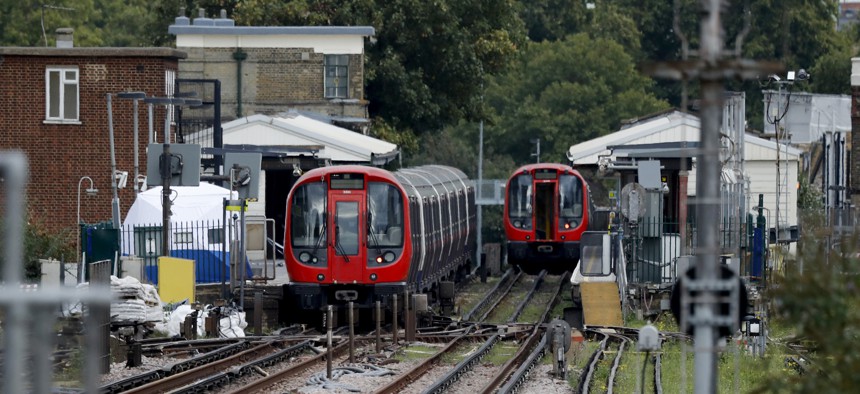
A police forensic tent stands setup on the platform next to the train, at left, on which a homemade bomb exploded at Parsons Green subway station in London, Friday, Sept. 15, 2017. Frank Augstein/AP
The Problem of Securing London's Tube
Friday's explosion was not fatal, but it shows how transit networks are especially vulnerable to terrorism.
At least 19 people were hospitalized Friday after an explosion went off on one of London’s underground rail lines, in an incident British authorities are treating as an act of terrorism. The explosion took place at approximately 8:20 a.m. local time on the District line near London’s Southwest Parsons Green station—a rush hour period during which, as one observer noted, the trains are often filled with commuters going to work and children going to school.
Mark Rowley, the head of London’s counter-terrorism unit, said the explosion was caused by an “improvised explosive device” that did not fully detonate. Images of the alleged device, which have been circulated through social media but not yet formally authenticated by authorities, show a white container with wires sticking out inside a shopping bag.
The explosion marks the fifth terrorist attack in the U.K. this year, following incidents near Westminster, the London Bridge, Finsbury Park, and Manchester. It also fits a recent pattern of attacks throughout Europe, including a foiled attack at Brussels’ central train station in June. Friday’s incident, however, marks the first significant attack on the London Underground in more than a decade. The last attack targeting the city’s intricate rail system took place on July 2005, in a series of coordinated suicide bombings that killed 52 people and injured more than 700 others. Considered the single worst terrorist attack to hit British soil to date, the incident prompted the city to revitalize the Underground’s security system, including outfitting it with more British Transport Police officers and closed-circuit television (CCTV) surveillance systems.
But it’s unclear if such measures will be enough to meet the current security threat—one Richard Walton, a senior associate fellow at the British defense and security think tank RUSI and the former head of Metropolitan Police’s Counter-Terrorism command, called “unprecedented.” “This is now the fifth terrorist attack with six plots also disrupted,” he told me in an email, adding that “there is grave concern that a terrorist cell is planning further attacks on the London underground system.”
He added: “London is used to terrorist attacks on its tube system and is very resilient. But people have never forgotten 7/7 in 2005.” Even beyond the difficulty of preventing attacks themselves, there’s the separate matter of how well the system can mitigate injuries when an attack does happen. In Friday’s explosion, some of the injuries resulted from the crush of panicked people fleeing into packed spaces towards narrow exits, rather than from the explosion itself.
Statistics released by the Home Office Thursday revealed the number of people arrested for terrorism-related offenses increased by 68 percent from 226 arrests to 379 arrests this past year, marking the highest number of terrorism-related arrests since 2001. Of the arrests, 105 resulted in terrorism-related charges, with 32 convictions thus far.
In response to the attack, Prime Minister Theresa May announced that there will be an increased deployment of armed police and security on the Underground. Beyond that, however, increasing security on the city’s sprawling transit system may prove challenging. As Brian Michael Jenkins, the director of the Mineta Transportation Institute’s (MTI) Transportation Security Center and a senior adviser at the RAND corporation specializing in terrorism and transportation security, noted in a February report, “Terrorist attacks on public transport create significant alarm—daily commuters and other passengers cannot easily avoid what they perceive as a source of danger. At the same time, it is not easy to increase security without causing inconvenience and unreasonably slower travel times, while creating vulnerable queues of people waiting to pass through security checkpoints.” The rare and statistically random nature of such attacks makes measuring the success of such security measures even more difficult.
One tactic the report notes as particularly valuable is enlisting public involvement by encouraging more commuters to call attention to suspicious behavior and objects, such as unaccompanied bags. “This is one of the few security measures for which it is possible to quantify results,” the report reads. “Using the MTI database, researchers looked at worldwide patterns in attacks aimed against buses, trains, and passenger ferries and found that in 300 incidents—just under 9 percent of all attacks on these targets—alert citizens, passengers, or officials thwarted an attack by discovering bombs before they could be detonated.”
Though May confirmed that the U.K.’s current threat level—which stands at “severe,” the second-highest tier indicating that an attack is “highly likely”—will not be increased, she did say it would remain under review as the investigation into the attack continues, adding that “the public should go about their daily lives, but remain vigilant.” As the BBC’s security correspondent Frank Gardner noted, a decision to increase the threat level to “critical,” its highest tier, could depend on whether authorities are able to apprehend the perpetrator behind the attack. As of this writing, Scotland Yard has announced no arrests.





